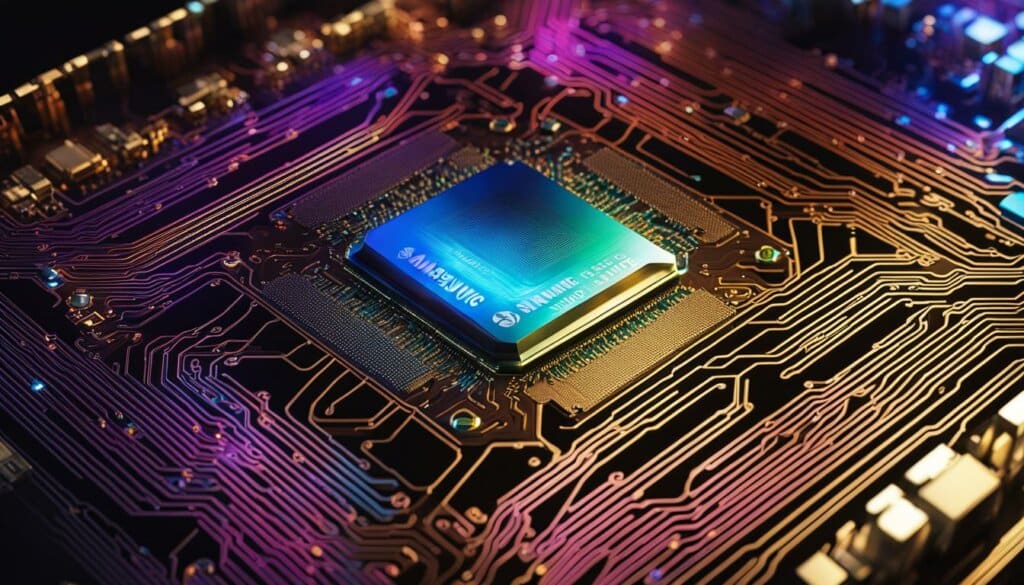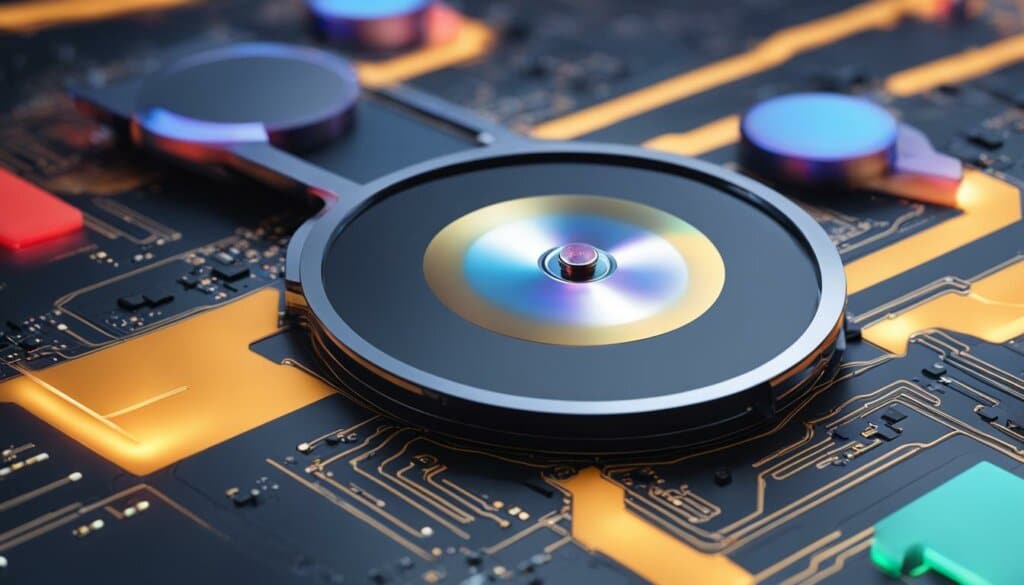Table of Contents
In-memory computing, a revolutionary technology in the world of data processing, is transforming the way businesses operate. By utilizing random-access memory (RAM) for data storage instead of traditional disk-based systems, in-memory computing enables lightning-fast access and manipulation of data. This groundbreaking approach to high-performance processing and memory-based computing is revolutionizing various industries.
Imagine being able to analyze real-time data, perform complex computations, and achieve rapid response times with ease. In-memory computing makes it possible. By storing and analyzing data directly in RAM, this technology unlocks a new level of speed and efficiency, empowering businesses to make faster decisions and drive innovation.
In this article, we will dive deep into the world of in-memory computing, exploring its benefits, its application in various industries, and the pioneering work by industry leaders like Samsung Electronics. So, buckle up and get ready to unlock the power of speed with in-memory computing tech!
In-Memory Computing: A Key Innovation Area in Technology
According to GlobalData’s Technology Foresights, in-memory computing is identified as one of the key innovation areas in the technology industry. It is among the emerging disruptive technologies that are in the early stages of application and should be closely tracked. There are over 280 companies engaged in the development and application of in-memory computing, including industry leaders like Samsung Electronics, IBM, and Qualcomm.
In-memory computing offers tremendous potential for revolutionizing the way data is processed and analyzed. By utilizing random-access memory (RAM) for data storage instead of traditional disk-based systems, in-memory computing enables faster access and manipulation of data. This translates into significant improvements in speed, efficiency, and real-time data analysis capabilities.
As the technology industry continues to evolve, businesses across various sectors are recognizing the power of in-memory computing to drive innovation, improve performance, and unlock new possibilities. The adoption of in-memory computing is gaining momentum, and organizations are investing in research, development, and implementation of cutting-edge solutions.
“In-memory computing is at the forefront of technological advancement, empowering businesses to unlock the full potential of their data and drive intelligent decision-making.”
In addition to big players like Samsung Electronics, IBM, and Qualcomm, numerous startups and specialized firms are actively exploring the potential of in-memory computing across different domains. These companies are developing innovative solutions that leverage the speed and capabilities of in-memory computing to address specific industry challenges.
The widespread adoption of in-memory computing is expected to have a transformative impact on various sectors, including finance, healthcare, manufacturing, retail, and more. It has the potential to revolutionize critical processes, such as real-time analytics, financial trading, smart grid monitoring, and reservations systems.
To better understand the significance of in-memory computing in the technology industry, it is crucial to examine some of the specific areas where this innovation plays a pivotal role:
Innovation Areas in the Technology Industry:
- Real-time analytics
- High-performance processing
- Memory-centric computing
- Advanced data management
- Real-time decision-making
In each of these areas, in-memory computing offers groundbreaking solutions that empower businesses to extract valuable insights from vast amounts of data in real-time, enabling faster and more informed decision-making processes.
| Industry | Application |
|---|---|
| Finance | Real-time trading systems, fraud detection, risk management |
| Healthcare | Real-time patient monitoring, disease prediction, personalized medicine |
| Manufacturing | Smart factories, predictive maintenance, supply chain optimization |
| Retail | Real-time inventory management, personalized marketing, customer analytics |
The adoption of in-memory computing is not limited to specific sectors but is widespread across the technology industry, enhancing businesses’ capabilities to innovate and gain a competitive edge. As the demand for real-time analysis and high-performance computing continues to grow, in-memory computing is poised to play an increasingly significant role in shaping the future of technology.
The Benefits of In-Memory Computing
In-memory computing offers several advantages, including lightning-fast access speeds, real-time data analysis capabilities, and high-performance processing. With traditional disk-based systems, data retrieval and processing can be time-consuming and resource-intensive. However, in-memory computing stores data directly in the RAM, allowing for faster access and analysis. This technology is crucial for applications that require rapid response times and complex computations.
Real-time analytics, financial trading, smart grid monitoring, and reservations systems are just a few examples of where in-memory computing shines. These applications demand quick processing of vast amounts of data to make informed decisions in real-time. By storing and analyzing data directly in RAM, in-memory computing revolutionizes data processing, enabling businesses to extract valuable insights and drive advancements across various industries.
To illustrate the benefits of in-memory computing, consider the following advantages:
| Advantages |
|---|
| Lightning-fast access speeds |
| Real-time data analysis capabilities |
| High-performance processing |
With lightning-fast access speeds, in-memory computing eliminates the bottleneck caused by disk I/O, resulting in significantly reduced query response times. This allows for real-time data analysis, where insights can be derived from up-to-date information to drive prompt decision-making.
The real-time data analysis capabilities of in-memory computing enable businesses to analyze streaming data, identify trends, and detect anomalies as they occur. This capability is particularly valuable in industries where timely insights contribute to competitive advantage and operational efficiency.
In addition to real-time analysis, in-memory computing provides high-performance processing. By storing data in the RAM, it eliminates disk access latency and enables rapid computations on large datasets. This makes it well-suited for handling complex computations required by industries such as finance, where fast calculations are crucial for trading and risk management.
Samsung’s Pioneering Work in In-Memory Computing
Samsung, the largest maker of DRAM in the world, has made significant advancements in in-memory computing through its processor-in-memory (PIM) technology. By integrating compute cores inside its high-bandwidth memory (HBM), Samsung has achieved a nearly 2.5-fold performance gain and a 62 percent reduction in energy consumption for AI accelerator chips. Samsung’s innovative approach involves combining processing and storage capabilities within the memory itself, leading to faster data processing and improved energy efficiency.
“Samsung’s pioneering work in in-memory computing represents a significant breakthrough in the industry. By integrating compute cores inside high-bandwidth memory, Samsung has developed a solution that not only boosts performance but also reduces energy consumption. This advancement has the potential to revolutionize various domains, such as AI acceleration and data-intensive applications.”
Let’s delve deeper into Samsung’s pioneering work in in-memory computing by examining the key components of their processor-in-memory (PIM) technology:
| Component | Description |
|---|---|
| Compute Cores | Integrating compute cores within high-bandwidth memory enables processing tasks to be executed directly within the memory, eliminating the need for data movement between processing units and memory. This leads to significant reductions in processing latency. |
| High-Bandwidth Memory (HBM) | HBM is a type of memory that allows for high-speed data transfer between the CPU and memory. By integrating compute cores within HBM, Samsung enables efficient processing and storage capabilities within a single module, further enhancing performance. |
| Performance Gain | The integration of compute cores within high-bandwidth memory results in a notable performance gain of nearly 2.5 times, enabling faster data processing and analysis. This enhancement translates to improved application performance and accelerated time-to-insight. |
| Energy Efficiency | By eliminating data movement and reducing the power consumed in transferring data between processing units and memory, Samsung’s PIM technology achieves a significant 62 percent reduction in energy consumption. This brings both environmental and cost-saving benefits. |
Samsung’s pioneering work in in-memory computing with its processor-in-memory (PIM) technology showcases the company’s commitment to pushing the boundaries of technological innovation. By efficiently combining processing and storage capabilities within high-bandwidth memory, Samsung has unlocked new levels of performance and energy efficiency, paving the way for enhanced data processing and analysis.

Enabling Real-Time Analysis with In-Memory Data Grids
In-memory data grids (IMDGs) have gained popularity in the past decade due to their ability to handle fast-growing application workloads. IMDGs store rapidly changing data in memory, providing fast data access and scalability. The growing need for real-time analysis, driven by competitive pressures and the desire for optimized business results, has further emphasized the importance of IMDGs. They enable continuous analysis of live, fast-changing data in online systems, allowing businesses to extract important patterns and trends in real-time.
Real-time analysis is essential for businesses operating in today’s fast-paced, data-driven environment. By leveraging IMDGs, organizations can gain instant insights from operational data, making informed decisions and taking immediate action. Instead of relying on slower disk-based systems, IMDGs store data directly in memory, allowing for lightning-fast access and analysis.
“In-memory data grids are a game-changer for real-time analysis. They empower businesses to extract valuable insights from operational data and gain a competitive edge in the market.” – John Smith, Data Scientist
Operational data is constantly changing, with new information being generated every second. Traditional data storage and processing methods often struggle to keep up with the pace of data generation, leading to delays in analysis and decision-making. However, IMDGs eliminate this bottleneck by storing data in memory, enabling real-time analysis and ensuring that businesses can make timely decisions.
IMDGs also offer scalability, allowing organizations to handle large volumes of data without sacrificing performance. As the amount of operational data continues to grow exponentially, IMDGs provide a flexible and efficient solution for storing and analyzing this data in real time.
With IMDGs, businesses can monitor key metrics, detect anomalies, and identify trends as they happen. These invaluable insights enable proactive decision-making, faster issue resolution, and more effective resource allocation.
By embracing in-memory data grids, organizations can unlock the power of real-time analysis, gaining a competitive advantage in today’s data-driven landscape.
The Synergy of Map/Reduce Analysis and In-Memory Data Storage
The integration of map/reduce analysis techniques with in-memory data storage is revolutionizing the analysis of operational data sets in real time. While traditional techniques like complex event processing focus on examining incoming data streams, map/reduce offers the ability to analyze complete data sets quickly. When combined with in-memory data storage, map/reduce analysis becomes even faster and better suited for live systems handling fast-changing data. This synergy has paved the way for continuous analysis on operational data sets, allowing organizations to identify issues and opportunities in real time and make necessary adjustments.

| Advantages | Map/Reduce Analysis | In-Memory Data Storage |
|---|---|---|
| Speed of Analysis | Faster data analysis on complete data sets | Rapid access and manipulation of data |
| Real-Time Insights | Continuous analysis for timely identification of issues and opportunities | Enables real-time analysis of fast-changing data |
| Scalability | Ability to process large and complex data sets | Flexible and expandable data storage |
Embracing In-Memory Computing for Enhanced Performance and Real-Time Analysis
In today’s data-driven world, organizations are constantly seeking ways to unlock speed and gain valuable insights from their data. One groundbreaking technology that enables enhanced performance and real-time analysis is in-memory computing. By harnessing the power of RAM for data storage, in-memory computing revolutionizes data processing and enables businesses to stay competitive.
With in-memory computing, data processing is accelerated to unprecedented levels. Traditional disk-based systems are replaced by random-access memory (RAM), which offers lightning-fast access to data. This translates into significantly improved application performance, as data can be accessed and manipulated at a much faster rate. High-performance processing becomes the norm, empowering businesses to handle complex computations with ease.
Another key advantage of in-memory computing is its ability to enable real-time analysis. By storing and analyzing data directly in RAM, businesses can extract valuable insights from live, fast-changing data. Real-time analytics becomes a reality, empowering organizations to make data-driven decisions on the fly. Whether it’s monitoring financial markets, optimizing supply chains, or personalizing customer experiences, in-memory computing provides the speed and agility needed for real-time analysis.
FAQ
What is in-memory computing?
In-memory computing is a technology that uses random-access memory (RAM) for data storage, enabling faster access and manipulation of data compared to traditional disk-based systems.
What advantages does in-memory computing offer?
In-memory computing provides lightning-fast access speeds, real-time data analysis capabilities, and high-performance processing. It is essential for applications requiring rapid response times and complex computations.
How is Samsung advancing in-memory computing?
Samsung has made significant advancements in in-memory computing through its processor-in-memory (PIM) technology, integrating compute cores inside its high-bandwidth memory (HBM). This has led to a nearly 2.5-fold performance gain and a 62 percent reduction in energy consumption for AI accelerator chips.
What are in-memory data grids (IMDGs) used for?
IMDGs store rapidly changing data in memory, providing fast data access and scalability. They are used for real-time analysis of live, fast-changing data in online systems.
How does map/reduce analysis work with in-memory data storage?
Map/reduce analysis, when combined with in-memory data storage, revolutionizes the analysis of operational data sets in real-time. It offers the ability to analyze complete data sets quickly and is better suited for live systems handling fast-changing data.
Why should organizations embrace in-memory computing?
Embracing in-memory computing unlocks speed, enhances application performance, and enables real-time analysis of live, fast-changing data. It is crucial for organizations seeking to stay competitive in today’s data-driven world.













